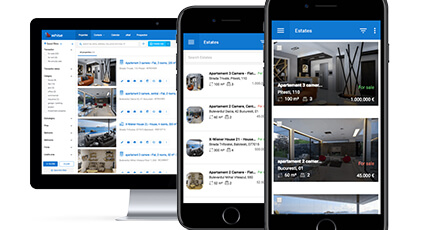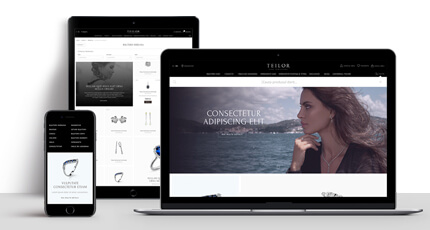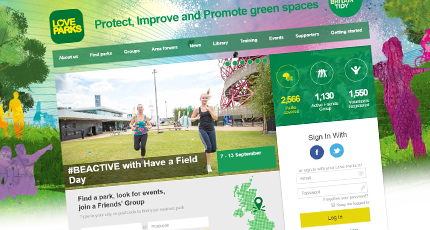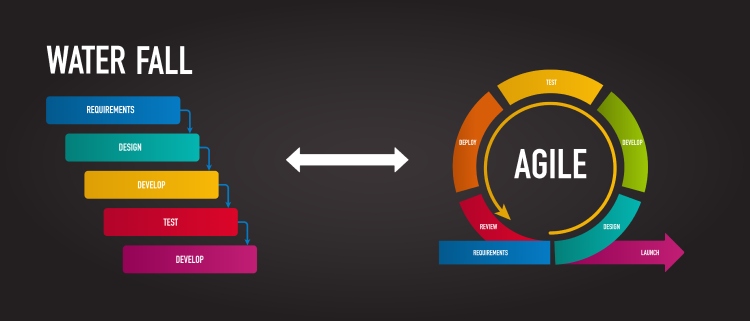
Agile or Waterfall?
Either you are a project manager or a company owner (interested to develop a digital product or a software solution), sooner or later you’ll have to make a choice on the development model.
Scroll down to find out:
- what is Agile?
- what is Waterfall?
- Waterfall vs. Agile
- the hybrid approach
- what methodologies do we use in Roweb
The Agile Model
The Agile methodologies have transcended their primary purpose, now being considered the modern way to deliver performance in the software development field and beyond it. Industries like marketing, sales, and other domains that are not specific to software borrowed Agile principles and proved that these methodologies could be applied widely.
Agile approach allows more adaptive and evolutionary processes, helping companies to respond to rapid market and technology shifts.
Agile has an interesting origin. Even if its start seems to be more likely in 1620 (Francis Bacon’s articulation of the scientific method), this methodology was better revealed in 1986 when it was built on the model provided by Hirotaka Takeuchi and Ikujiro Nonaka (authors of “The New New Product Development Game”). The concept was related to the rugby principles in a metaphorical perspective for defining the way teams work together on the field:
“The ‘relay race’ approach to product development may conflict with maximum speed and flexibility goals. Instead, a holistic or ‘rugby’ approach – where a team tries to go the distance as a unit, passing the ball back and forth – may better serve today’s competitive requirements.”
Getting back to our days, you may be wondering why Agile is the first-choice approach for software development.
Let’s take a quick peek at what stats say:

The most popular and common examples of Agile methodologies
- Scrum – a structural Agile approach based on a complex of management principles. Its main focus is on getting things done faster by dividing work into stages – sprints;
- eXtreme Programming (XP) – focused on frequent releases and short development cycles;
- Feature Driven Development (FDD) – the development process is focused on generating progress on features;
- Dynamic Systems Development Method (DSDM) – focused on the full project lifecycle using fixed timelines;
- Adaptive Software Development (ASD) – is about repeating series of speculating, collaborating, and learning cycles.
- Crystal – its core principle is about empowering teams to find and implement their own solutions: “people over processes.”
- Lean Software Development (LSD) – focused on optimizing the development time and resources.
How Agile model works
Agile is a collaborative, self-organizing, and cross-functional approach that was designed to help the development team managers better coordinate and balance work among workers.
Agile methodology relies on dividing the system into vertical processes – small and manageable – that can be delivered in a specific short period of time.
Main Agile lifecycle phases:
- Requirements
- Design
- Crafting code and developing
- Integration and testing
- Implementation and deployment
- Review
Advantages
- Provides more space for collaboration (e.g., between the client and the dev team);
- The client is more engaged in the software development process;
- High predictability and early deliveries (making possible the testing ahead of schedule);
- User-driven approach (relies on a user-centered mindset);
- Provides improved quality (being split into small and easy manageable units);
- Fast development and delivery;
- High flexibility (the system can be easily adapted to changed requirements);
- Value-focused development (focused on end-users needs).
Challenges
- Permanent testing;
- Requires more interactions;
- Reduced document load;
- Higher complexity in defining the project’s objective/s;
- Higher team independence.
This model is suitable for…
Agile is a great choice, that’s for sure. But is it right for any type of projects/companies?
Agile is right for you if:
- you need to optimize a project frequently;
- the project has poor defined/dynamic requirements;
- the stakeholders are located in proximity;
- you can rely on engaged and leading crew members.
The Waterfall Model
Known as a traditional model for development processes, Waterfall is a fixed, linear methodology that relies on sequential Systems Development Life Cycle (SDLC) phases. Therefore, well-defined requirements and a detailed development plan that must be established from the start are prerequisites that make the Waterfall approach a predictable but also rigid one.
Relying on the “measure twice, cut once” mindset, the Waterfall model requires high attention on the project definition and documentation phase – the rest of the process depending on it. Thus, we can say that the Waterfall model is created on the domino principle: one piece’s failures will impact the entire process instantly.
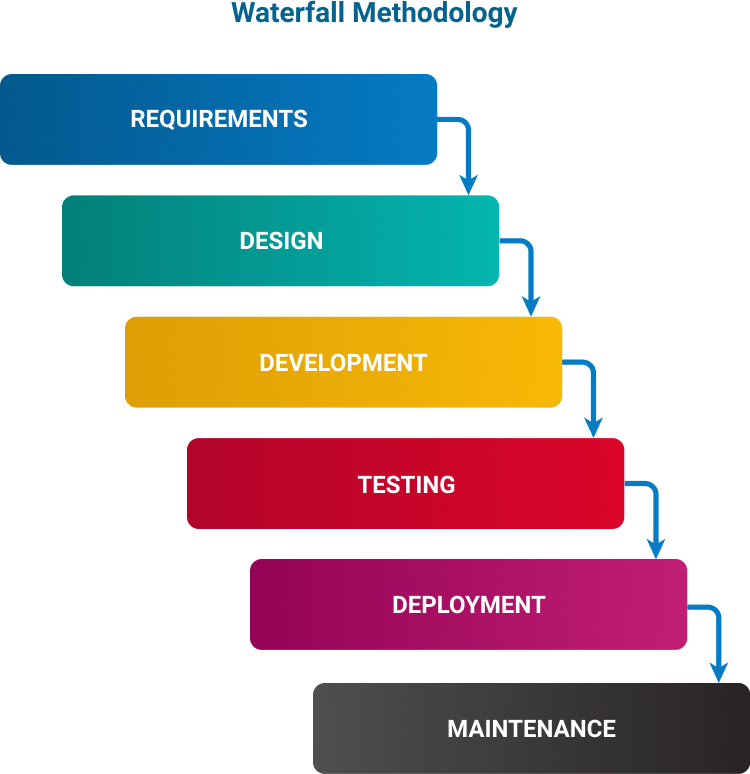
How Waterfall model works
The Waterfall model relies on 5 main stages and works like a chronological process where every step is mandatory. Team members work most of the time independently, and they deliver reports for providing the project’s status, so collaboration is not essential.
The main 5 stages of the Waterfall model are:
- Requirements
- Design
- Implementation
- Testing
- Deployment & maintenance
Advantages
- early errors detection;
- accurate cost estimations;
- easy progress tracking;
- well-defined requirements;
- fast acclimatization for new developers;
- more stability in the project’s dynamic.
Challenges
- lack of flexibility;
- any delay could impact the entire project;
- clients are not involved in the process;
- a linear approach sometimes = rigidity.
This model is suitable for…
- projects with established requirements;
- clients that have no intention to change the solution later;
- companies that expect predictable costs and development processes.
Usually, digital products fit best into developments on the principles of Waterfall.
Waterfall vs. Agile
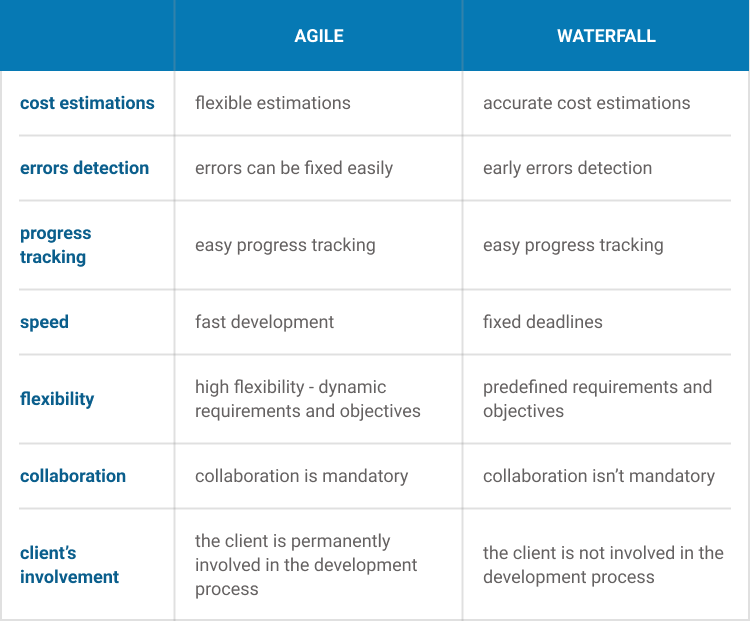
The hybrid approach
The hybrid approach is a great idea for your projects either you want to make the transition from a traditional approach (Waterfall) to Agile, or you are interested in having both fixed project prerequisites (requirements, budgets. objectives) and Agile’s fast development process (design, planning, etc.)
The Agile-Waterfall method is used for developing software and products (that have both hardware and software).
What makes it possible for these two methodologies to work best together is the fact that Agile is more a philosophy that empowers Waterfall to adjust its structure to a more flexible approach.
What methodologies do we use in Roweb
From the Waterfall approach to Agile methodologies (especially Scrum and Scrumban), and the hybrid approach (Agile + Waterfall), we have extended experience working with several types of models.
Once we identify our clients’ needs and opportunities in the analysis/audit phase, we establish (together with the clients) the model that responds to the projects’ needs best, the team (e.g., dedicated development team allocated to the project), etc. About Roweb’s dedicated development team in a nutshell: The main aim of the dedicated team is to work seamlessly as part of the client’s team to provide quality, unique and project-specific solutions. With more than 130 developers, we can offer you a complete team of experienced developers or a dedicated pool of developers with the appropriate technical capabilities for your particular needs.
We work for:
- companies that need to hire and secure cost-effective IT talent for the project;
- companies interested in developing new products without defocusing the core team;
- dynamic companies with ever-changing development goals, which cannot afford a long-lasting hiring process;
- start-ups that need to augment the development team to achieve their business goals.
Selecting the right outsourcing company: top criteria you must take into account
- 10+ y of experience on the IT market – a guarantee that experienced teams will take over your project;
- various projects in the company’s portfolio – illustrative both for dedicated teams and for your industry;
- large and stable number of employees – the more employees a company has, the easier will be for it to provide you the team you need;
- team roles provided by the company – an extra-guarantee that you can count on a complete team for developing your project;
- disruption-free recruitment projects – recruitments processes based on modern and efficient technologies.
Our outsourcing story: what is our approach in providing outsourcing services to our clients?
Roweb is a custom software development company, started in 2004 with offices in 4 major cities: Bucharest, Pitesti, Craiova and Ramnicu Valcea.
With our 130+ IT professionals’ experience and the latest software development technologies, we focus on building Business, Web, Mobile applications, and E-commerce solutions.
We work with companies from all over the world, and we understand the needs of and provide solutions for companies of all sizes ranging from start-ups to large business.
“I started the company in 2004 with the business purpose of creating software that would solve the client’s problems. The idea behind this was a company that would offer competitive services, from a quality and price point of view, to build a portfolio of clients with whom to grow and develop ourselves and grow together with our businesses. We are dedicated to staying ahead of the rapid changes by working with the latest technologies so that our clients would benefit from our technology expansion.
Our mission is to continually keep up with the innovations in the technological world so that the developed software does well in the market.”
Viorel Costea | Co-Founder & CEO Roweb
(Read more about our outsourcing models and services from the article Dedicated team model: our approach (interview + case studies)
We have an in-house team of software professionals who manage end-to-end product development projects, from business analysis, consultancy, and architecture, to post-implementation testing and maintenance.
“We are always interested in building long-lasting teams. It is essential to save the project’s optimal cost, so we consider the different levels of tasks required by the project, their duration, and workload. For most projects, the best team configuration includes junior, middle, and senior developers. Our employer branding strategy implies hiring junior developers from the university, and we continuously invest in their professional growth.”
Viorel Costea | Co-Founder & CEO Roweb
Need support for starting a new outsourcing-based project? Book a free consultation session with one of our experts!

